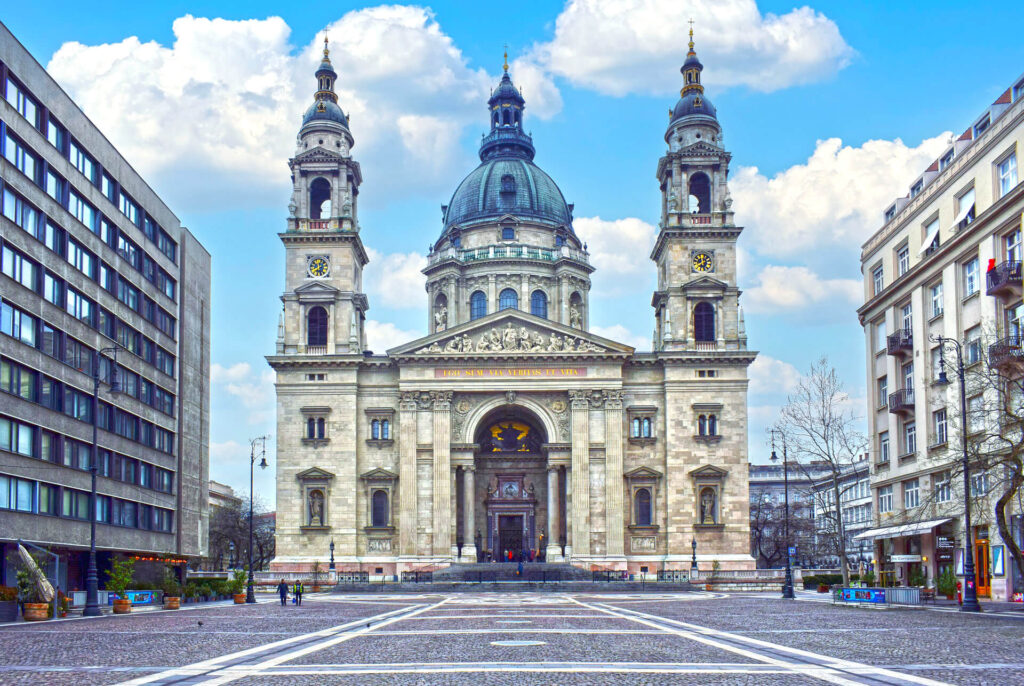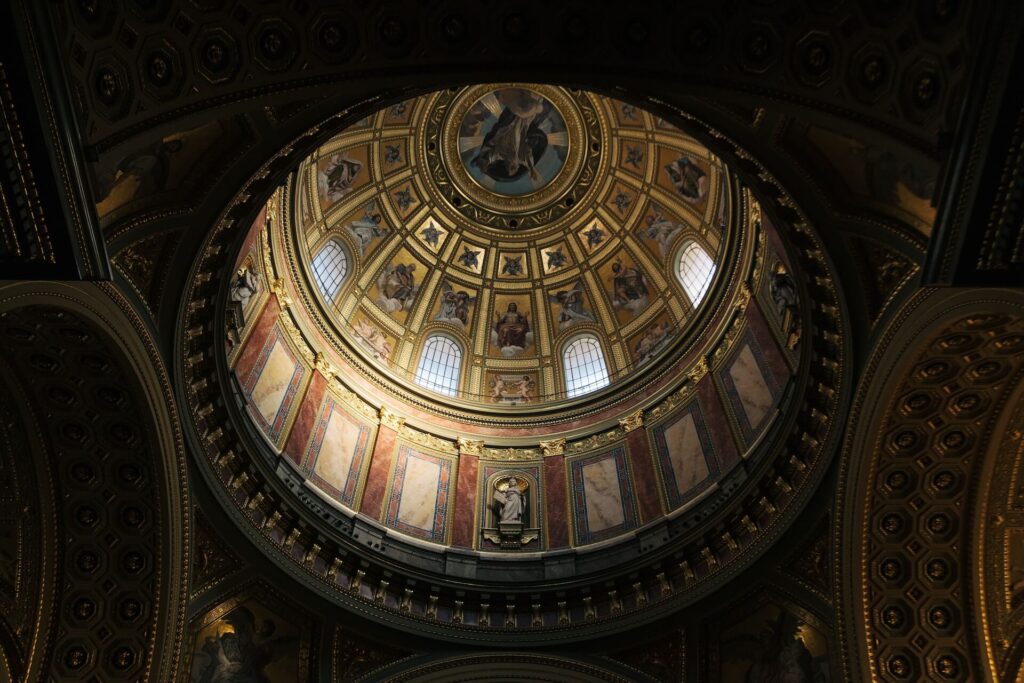St. Stephen’s Basilica

Admission
As of January 2023, there has been a change in the entrance fee policy for the basilica. Instead of the previous HUF 200 donation, a compulsory admission fee of HUF 2,000 is now charged at the entrance.
The fee to explore the panoramic view is set at HUF 3,200.
A Brief History of St. Stephen’s Basilica
The construction of St. Stephen’s Basilica began in 1851 and was completed in 1905, after 54 years of meticulous work. The site where the basilica stands today was previously occupied by a theater called Hetz-Theater, which hosted animal fights. A wealthy citizen named Janos Zitterbarth financed the construction of a temporary church within the theater. In the late 1810s, a thousand people formed the Lipotvaros Parish and initiated fundraising for the future church.
The basilica is dedicated to Stephen I of Hungary, who played a pivotal role in establishing Christianity in the kingdom during his reign from c. 975 to 1038. The church’s construction was led by renowned architects, including Jozsef Hild and Miklos Ybl, who oversaw the project after the collapse of the dome in 1868. The basilica also endured damage during the Second World War and subsequent renovations were undertaken to restore its magnificence.

What to See at St. Stephen’s Basilica
St. Stephen’s Basilica is home to several impressive works of art, including the largest bell in Hungary, which weighs over 9 tons, and a beautiful marble altar. The church also houses several chapels, including the Chapel of the Holy Right, which is home to the mummified right hand of St. Stephen, and the Chapel of St. Michael, which features stunning stained glass windows.
One of the highlights of visiting St. Stephen’s Basilica is climbing to the top of the dome, which offers stunning panoramic views of the city. There is an elevator that takes visitors up most of the way, but there are still several flights of stairs to climb to reach the observation deck. The climb can be challenging, but the views from the top are well worth it.
Top of the Dome Panoramic Views

To reach the top of the Dome, visitors can take an elevator or climb 364 stairs. Once there, you’re treated to a breathtaking 360-degree view of the city. Here’s what you can expect:
- River Danube: From the top, you’ll see the beautiful blue ribbon of the Danube River snaking through the city, with various bridges connecting Buda and Pest.
- Buda Castle: Looking towards the hilly Buda side, you’ll have a clear view of the historical Buda Castle, a UNESCO World Heritage Site that houses the Hungarian National Gallery and the Budapest History Museum.
- Hungarian Parliament: Looking across the Pest side, the Gothic Revival-style Hungarian Parliament Building by the river is a stunning sight, particularly if you’re up the dome near sunset.
- City Landscapes: Beyond these iconic landmarks, the sweeping city view showcases Budapest’s blend of architectural styles – from medieval buildings to modern structures. You can see many of the city’s famous thermal baths, the Budapest Eye Ferris wheel, and much more.
- Hills and Skyline: The panorama also takes in the verdant Buda Hills and the varied Budapest skyline, allowing you to truly appreciate the city’s mix of natural beauty and architectural grandeur.
The panoramic view from the top of St. Stephen’s Basilica’s Dome is a feast for the eyes and an excellent way to familiarize yourself with the layout of Budapest. Don’t forget your camera – the view provides a fantastic photo opportunity.

Architecture Marvel of St. Stephen’s Basilica
St. Stephen’s Basilica showcases exquisite Neo-Classical architecture with a Greek cross ground plan. Its impressive facade features a grand Neo-Classical entranceway and two bell towers on each side. The southern tower houses the largest bell in Hungary, while the other five bells are located on the north side. The basilica’s dimensions are awe-inspiring, with a length of 87 meters, a width of 55 meters, and a maximum height of 96 meters, equaling the height of the Hungarian Parliament Building.
Inside the basilica, visitors are treated to a visual feast of sculptures, mosaics, statues, and paintings by prominent Hungarian artists. The main treasure of the church is the Holy Right Hand, believed to belong to King Stephen I. This relic is housed in a precious reliquary and holds immense religious significance for the Catholic faithful.
Opening Hours and Visitor Information
St. Stephen’s Basilica is conveniently located in the heart of Pest, making it easily accessible for visitors. The nearest underground station is Arany Janos, which is served by the M3 line. The basilica is open to the public from Monday to Friday, from 9 am to 5 pm. On Saturdays, it is open from 9 am to 1 pm, and on Sundays, it welcomes visitors from 1 pm to 5 pm.
For a more in-depth experience, guided tours are available, allowing visitors to explore the chapel featuring the relic of King Stephen’s hand, as well as the basilica’s treasures and the breathtaking dome. These tours provide valuable insights into the history, art, and spirituality embodied by St. Stephen’s Basilica.
Address: Budapest, Szent István tér 1, 1051 Hungary
Tips for Visiting St. Stephen’s Basilica
St. Stephen’s Basilica is a functioning church, so it’s important to dress appropriately when visiting. This means covering your shoulders and knees, and avoiding wearing shorts or revealing clothing.
If you plan to climb to the top of the dome, make sure to wear comfortable shoes and bring a bottle of water. The climb can be tiring, especially if you’re not used to climbing stairs, so it’s important to take breaks if you need to.
It’s also a good idea to visit St. Stephen’s Basilica early in the morning or later in the afternoon, when it’s less crowded. The church can get very busy during peak hours, and this can make it difficult to fully appreciate the beautiful architecture and artwork.
FAQs
What is St. Stephen's Basilica?
St. Stephen's Basilica is one of the most significant religious buildings in Hungary, named after the country's first king, St. Stephen. It's a Roman Catholic basilica located in the heart of Budapest. Besides being a functioning church, it's also a major tourist attraction.
Why is St. Stephen's Basilica famous?
The Basilica is renowned for its stunning Neoclassical architecture, rich history, and its religious significance. It houses the "Holy Right Hand," the mummified right hand of St. Stephen, which is a revered relic in Hungary.
What are the opening hours of St. Stephen's Basilica?
The Basilica is usually open daily, with shorter hours on Sundays and during religious holidays. Always check the official website or contact the Basilica directly for the most accurate and current information.
How much does it cost to enter St. Stephen's Basilica?
The entrance fee to the Basilica is HUF 2,000, and to visit the panorama from the dome, it costs HUF 3,200. However, these prices may have changed, so please check the official website for the latest information.
Can I take a guided tour of the Basilica?
Yes, guided tours are often available and provide a deeper understanding of the Basilica's history, art, and architecture. Some tours may require an additional fee.
Is there a dress code for visiting St. Stephen's Basilica?
As it's an active place of worship, visitors should dress respectfully. Generally, this means avoiding clothing that reveals too much skin, such as short shorts or tank tops.

